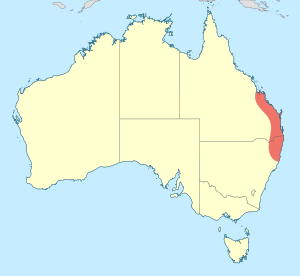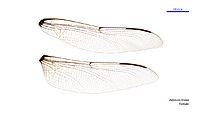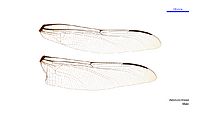Coastal petaltail facts for kids
Quick facts for kids Coastal petaltail |
|
|---|---|
| Conservation status | |
| Scientific classification | |
 |
The Coastal petaltail (scientific name: Petalura litorea) is a special type of dragonfly found only in Australia. It belongs to a family of dragonflies called Petaluridae. This amazing insect is currently listed as an endangered species.
You can find the Coastal petaltail in south-eastern Queensland, Australia. It loves to live in swampy areas with lots of plants. Often, you'll spot them resting on tall sword grass. Because it's endangered, the New South Wales government has listed it as a protected species.
What Does a Coastal Petaltail Look Like?
Coastal petaltails have very unique bodies. An average petaltail is about 10 cm (4 in) long. They have wide-set eyes and a black body section called a thorax. This thorax is covered in bright yellow spots. Their long tail, called an abdomen, has a similar pattern of black and yellow stripes.
Their wings are also special! They have long, thin marks called pterostigmata that run along the sides of their wings. If you look closely, you can tell the difference between males and females by their wings. Female petaltails have rounded wings, while males have wings with more angular, sharp corners.
How Do Coastal Petaltails Find a Mate?
Male Coastal petaltails have a very cool feature: bright orange parts at the end of their bodies. These are called 'petaltails'. Scientists believe these colorful petaltails help the males attract a female mate.
Once a male and female find each other, they begin to mate. It's quite a sight! The female faces upwards towards the sky, and the male positions himself upside down. This mating process can last for about thirty minutes.
After mating, the female dragonfly goes off to lay her eggs. She usually lays them in a small burrow or hole, often very close to a body of water. The baby dragonflies, called larvae, grow inside these burrows. Sometimes, underwater predators can easily reach the burrow from the nearby water, which can be dangerous for the young larvae. If the larvae survive and grow up, an average Coastal petaltail can live for about 6 years.
Gallery




